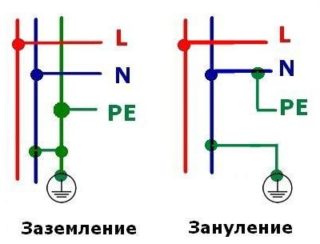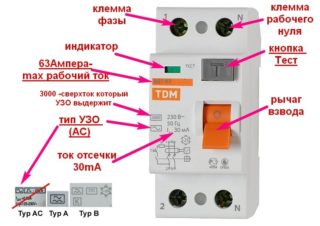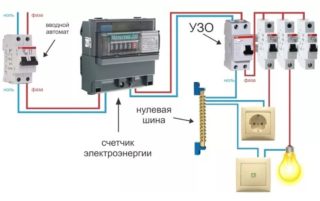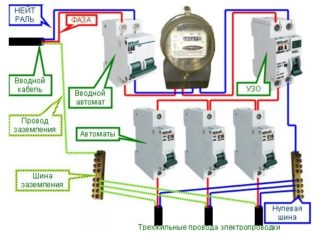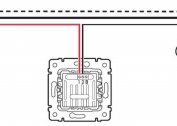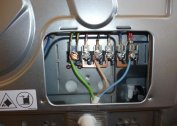When operating existing power grids, it is important to worry about the safety of service personnel and consumers using their services. According to the requirements of the PUE, this applies to both single-phase and three-phase circuits, which are often equipped in private homes. To protect users from electric shock, devices called residual current devices (RCDs) are installed on the consumer side. It is important to know how to connect an RCD with grounding in a private house, without violating the provisions of existing standards.
A general view of defense
The safety of operating personnel and users of power grids is achieved through the following activities:
- grounding or grounding (connection to neutral) of all metal parts of the equipment;
- organization of re-grounding by arranging a separate circuit;
- installation in load chains of especially dangerous rooms (bathrooms, for example) of UZO-type trip devices.
The latter option can be used both in grounded and in non-grounded electrical circuits.
With a general approach to the assessment of protective equipment, it is noted that the grounding of structures is necessary to reduce the potential threatening a person to a safe level. In contrast, RCDs provide security by instantly disconnecting the network when leakage currents reach their limit values. In the technical characteristics of these devices, this parameter refers to the main indicators of operational efficiency.
What is an RCD
In deciphering the abbreviations of RCDs, the main emphasis is on shutdown, which indicates the cardinal nature of protective measures. To understand how this device works in a dangerous situation, you should familiarize yourself with its design. The UZO device consists of the following main parts:
- a differential device in which inflowing and outflowing currents are compared;
- an electronic circuit capable of responding to their imbalance;
- an executive module, designed in the form of a contactor, disconnecting the mains from the consumer.
The principle of the protective action of the RCD is based on the features of its design, which allow us to estimate the amount of leakage to the ground and instantly respond to them. Due to the high speed of disconnection from the existing network, the current in the load does not have time to reach critical values.
Traditional RCD connection schemes
In household electrical networks with sockets and lighting devices installed in them, RCDs without grounding are used, which is typical for the TN-C protection system. In accordance with the features of its functioning, from the station equipment to the consumer, a line is drawn in which only the combined PEN conductor is provided. As a rule, it is not divided into a protective bus PE (an earthing circuit is connected to it) and working N is not carried out in apartment buildings.
Classic RCD without grounding
Usually, RCD devices are connected to non-earthed networks of domestic consumers, the power of which is organized by means of a two-wire line. All that they guarantee is its shutdown if the leakage current exceeds the permissible value (30 mA, for example). Such switching devices, such as power failure during overload or short circuit, cannot provide these devices. Therefore, RCD connection schemes in single-phase networks require the obligatory presence of an automatic circuit breaker and overload protection device in them.
The range of currents for which the circuit breaker is calculated is selected individually for each specific load line. The joint work of these two devices guarantees reliable protection of a person from high voltages in the bath, for example. At the same time, their use allows you to protect household appliances operated in a modern apartment from failure. Quite often, a circuit breaker together with an RCD is replaced with a difavtomat, which contains both devices in a common case.
Group and multi-stage protection
With the so-called "group" switching on of the RCD, a separate device with a circuit breaker or a difavtomat is placed on a dedicated line. In this case, each of the load groups connected to the network is served independently of the others, which increases the selectivity of the protective functions. As a result, the safety of using household appliances in each room increases markedly.
Greater security is provided by a stepwise scheme in which a group of loads is connected to the network through another similar device (it forms the second stage). The use of these systems allows to increase the reliability of protection in comparison with the classical one. But because of the complexity of execution and technical redundancy in everyday life, they are used extremely rarely.
RCD connections in a grounded network
A typical RCD connection diagram in a single-phase network with grounding is built according to the same rules, according to which it is mounted immediately after the energy meter. The difference lies in the presence of a separate bus in it, bypassing a set of protective devices. At the same time, the reliability of operation of each of the devices is significantly increased due to significant leakages along the “phase – equipment case – earth” circuit.
Special operations for arranging protection in this case are not required. If there is a protective circuit in a private house, for example, it is not difficult to ground an existing electric network with an RCD. To do this, splitting should be done on the main grounding bus (GIS), and then draw a branch from the PE conductor.
Which circuit is better
When evaluating the considered schemes, they proceed from the level of security that each of them provides. To solve this issue, it will be necessary to compare them not only in terms of protection efficiency, but also in terms of implementation costs. After careful study, the following conclusions can be drawn:
- With a limited number of linear consumers, the simplest set of devices is used, consisting of one RCD and a linear machine standing behind it.
- In the case of a branched network of single or three-phase loads, group switching is preferable.
- With high safety requirements, step-by-step connection of protective devices is allowed.
The latter method is optimal for a private house.
Before connecting an RCD without grounding in private homes, the circuit of its switching should be carefully studied. In this case, the most reliable option is the use of multi-stage systems from several devices with different values of current leakage.
Modern summer houses are distinguished by a developed power supply system with good protection against electric shock due to the presence of re-grounding. Therefore, they use simplified schemes involving the use of universal RCDs for leakage currents up to 30 mA (for separate protection of a water heater, for example). But most often preference is given to standard differential devices designed for the appropriate cut-off for overloads.
Typical errors include irregularities in the choice of the RCD installation level when it is included in circuits with improperly selected leakage currents.To avoid violations of the rules for connecting the lead-in and lead-out conductors, when switching them, they are guided by a circuit on the device body.
